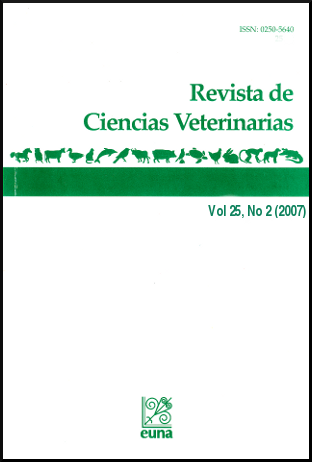Características diagnósticas de tres métodos coprológicos para detectar Giardia spp. en caninos, utilizando un ELISA de captura como prueba de oro
Keywords:
Giardiosis, perros, diagnóstico, Costa Rica, Giardiasis, dogs, diagnosisAbstract
La giardiosis canina, causada por Giardia spp., produce un síndrome de mala absorción y diarrea que cobra especial importancia en medicina veterinaria y salud pública por ser una zoonosis; así, el diagnóstico oportuno se torna entonces un aspecto crucial en su control. Este estudio analiza las capacidades diagnósticas de tres métodos utilizados en un laboratorio de diagnóstico médico veterinario (microscopía directa, flotación con cloruro de sodio y tinción con hematoxilina férrica de Heidenhain), comparándolos con un ELISA de captura (SNAP® Giardia Test Kit (IDEXX®)) como prueba de oro. Se analizaron 115 muestras de heces caninas sospechosas de giardiosis provenientes de clínicas veterinarias del Valle Central, remitidas al laboratorio ACOPSA, localizado en Heredia. Las muestras fecales –una sola por perro sospechoso de giardiosis- se recolectaron entre marzo y agosto de 2005. A todas las muestras se les realizaron las cuatro técnicas. Se determinaron los atributos diagnósticos de las otras pruebas (sensibilidad, especificidad, valores predictivos positivos y negativos) utilizando tablas de 2x2. De las 115 muestras fecales 30 fueron positivas a una o a varias de las técnicas estudiadas, y de ellas 29 fueron positivas al SNAP® Giardia. Las tres pruebas mostraron la misma especificidad (98,8%), pero variaron en la sensibilidad: hematoxilina férrica de Heidenhain (58,6%), flotación con cloruro de sodio (48,3%) y microscopía directa 20,7%. Este estudio demuestra que las pruebas coproparasitológicas tradicionales, aplicadas a una sola muestra de heces de un perro sospechoso, no ofrecen resultados fiables que reflejen el estado infeccioso de un perro respecto a la Giardia spp., como si ocurre con el SNAP Giardia; sin embargo, en ausencia de ésta, la tinción con hematoxilina férrica de Heidenhain sería el método diagnóstico convencional para el diagnóstico de Giardia spp.
ABSTRACT
Canine giardiosis, caused by Giardia spp., produces diarrhea and malabsorption syndrome and it is especially important in veterinary medicine and public health because it is a zoonosis; then, an early diagnosis becomes a crucial aspect on its control. This study analyzes the diagnostic ability of three diagnostic methods (direct microscopy, NaCl flotation, Heidenhain’s iron hematoxylin), compared with a capture ELISA (SNAP Giardia Test Kit (IDEXX ®)) as gold standard test. A total of 115 fecal samples suspicious of giardiosis -only one by dog- collected from March to August 2005 and remitted to the ACOPSA laboratory in Heredia from veterinary practices of the Central Valley, were analyzed. Each sample was assayed with the four methods. The attributes (sensitivity, specificity, positive and negative predictive values) of the traditional methods were assessed using 2x2 tables. Thirty samples resulted positive to one or several techniques, among them 29 were positive to the SNAP Giardia. All tested methods showed the same specificity (98.8%) but the sensitivity varied: Heidenhain’s iron hematoxylin (58.6%), NaCl flotation (48.3%) and direct microscopy (20.7%). This study shows that copropasitologic techniques, applied to a sole faecal sample, do not offer reliable results about the infectious state of a dog respect to the Giardia spp. as SNAP Giardia does; however, in the absence of this, Heidenhain’s iron hematoxylin would be the conventional diagnostic method for diagnosis of Giardia species.
Downloads
Published
How to Cite
Issue
Section
License
Licensing of articles
All articles will be published under a license:

Licencia Creative Commons Atribución-NoComercial-SinDerivadas 3.0 Costa Rica.
Access to this journal is free of charge, only the article and the journal must be cited in full.
Intellectual property rights belong to the author. Once the article has been accepted for publication, the author assigns the reproduction rights to the Journal.
Ciencias Veterinarias Journal authorizes the printing of articles and photocopies for personal use. Also, the use for educational purposes is encouraged. Especially: institutions may create links to specific articles found in the journal's server in order to make up course packages, seminars or as instructional material.
The author may place a copy of the final version on his or her server, although it is recommended that a link be maintained to the journal's server where the original article is located.
Intellectual property violations are the responsibility of the author. The company or institution that provides access to the contents, either because it acts only as a transmitter of information (for example, Internet access providers) or because it offers public server services, is not responsible.







